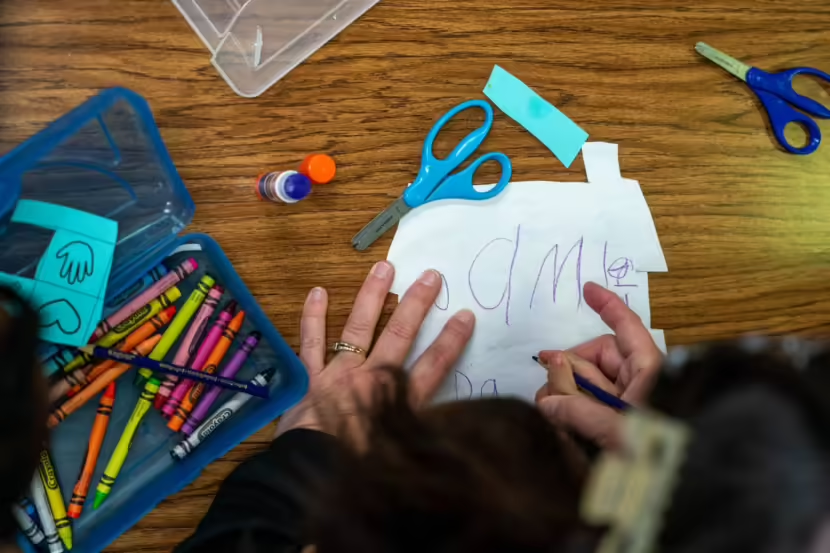
The Alaska Department of Education and Early Development is considering a regulation change that would tighten restrictions on how local governments fund schools.
Currently, municipalities can fund education in areas such as student transportation, school activities and preschool outside of school district’s operating funds. That allows local governments to fund education beyond a strict cap set in state law, which is intended to ensure funding is shared evenly among school districts.
The state of Alaska has chosen to impose that cap so that it can effectively deduct roughly $90 million from what it gives each year to school districts and use that money for other purposes. That is allowed under federal law.
Under that federal law, education funding must be evenly distributed among all of a state’s school districts — state, federal and local education funding in an urban school district can’t all add up to thousands more per student than the total amount of state, federal and local funding per student in a rural Alaska school district.
The state education department said the policy change is intended in part to ensure that local governments do not violate the state limit on local contributions. State education officials had long warned that the new restrictions could be coming.
A spokesperson for the state education department did not respond to a request for an interview, and instead asked that questions be submitted by email.
Lisa Parady, executive director of the Alaska Council of School Administrators, said requiring more local contributions to fit under the state’s limit could cause “essential services” to be cut for schools. From an initial survey, ACSA said the proposed policy change could affect 20% to 25% of Alaska school districts.
Anchorage and Juneau schools could be the hardest hit. The Anchorage School District could effectively face $11 million in cuts if the regulation is adopted as written. The Juneau School District could see even bigger cuts relative to its operating budget, proportionally, at close to $2.3 million.
“I’m a graduate of Alaska’s public schools, and I’ve been an educator in Alaska for nearly 30 years. I believe people statewide need to sit up and take notice of this,” Juneau Superintendent Frank Hauser said.
Clayton Holland, superintendent of the Kenai Peninsula Borough School District and the head of the Alaska Superintendents Association, said with flat state formula funding, more districts could be affected as costs increase with inflation.
“Really, whatever change happens is going to impact all of us,” he said.
The disparity test
The roughly $90 million in federal funding at stake comes from something called the Impact Aid program.
Alaska received $119 million last fiscal year in federal Impact Aid for education. That funding is intended to reimburse school districts for revenue that is effectively lost from federal land that is not subject to local taxes. Tribal land qualifies in that definition, and so do properties lived in by military families and military bases.
The Anchorage School District, with Joint Base Elmendorf-Richardson, was eligible for almost $17 million in Impact Aid last fiscal year. The Lower Kuskokwim School District — with vast expanses of tribal land — was eligible for $21 million, state data shows.
The state of Alaska was required to pass that $119 million in federal Impact Aid on to school districts. However, Alaska chooses to use an exception to that requirement, which is known as the disparity test.
The disparity test is a little-known federal rule that measures how evenly education funding is shared among school districts. For the state of Alaska to pass the test, there must be less than a 25% difference in per-pupil funding between its highest- and lowest-funded school districts.
By passing the disparity test, the state of Alaska is able to count roughly $89 million of that federal Impact Aid as the state’s contribution to school districts.
A spokesperson for the U.S. Education Department said by email that Alaska is the only state currently using that process to effectively reduce its funding to school districts.
Outside the cap
For more than 25 years, there has been a limit on how much municipal governments can contribute to education to ensure Alaska passes the disparity test. If the state fails the test, it could be on the hook to pay the roughly $89 million to school districts.
The state education department acknowledged the federal government had not provided new information that Alaska was at risk of failing the disparity test.
The Municipality of Anchorage and the City and Borough of Juneau have long funded education beyond the state’s cap in areas they consider outside of operating expenses.
Anchorage is planning to contribute $9 million this fiscal year outside the cap for student transportation and $2 million for eight pre-kindergarten classrooms from alcohol tax revenue. Katie Parrott, senior director of the district’s Office of Management and Budget, said it was unclear if the preschool funding would be restricted by the new regulation.
“That’s certainly, I think, a question that we have as well,” she said.
Two fiscal years ago, Juneau paid $2.3 million for student transportation, child care, and sports equipment outside of the cap on local contributions, KTOO reported.
The new regulation could require that spending be placed in school district’s operating funds. Because Anchorage and Juneau fund schools beyond the state’s limit, both districts could need to make budget cuts if the new state restrictions are approved, local education officials said.
”What happens is that reduces the potential amount of money that is available for instructional programs,” Hauser said in a Wednesday interview.
The Alaska Superintendents Association has so far surveyed 25 of 53 Alaska school districts about the potential impacts of the regulation change. Eleven districts said they get the maximum local contribution for operating expenses.
Funding outside the cap has been used primary for extracurricular activities, pupil transportation and feeding students, according to the preliminary survey.
”If communities think this won’t affect them, think what transportation costs and food service contracts will cost five years down the road, and what happens as state funding continues to be outpaced by inflation?” Hauser said by email.
State’s concerns
A spokesperson for the state education department said the new draft regulation is being considered to “address an inconsistency in interpretation” of state law, and to ensure compliance with the federal disparity test.
For the current fiscal year, the state education department said that Alaska’s preliminary data show that it would pass the disparity test.
In an April letter to the Alaska Superintendents Association, the director of the federal Impact Aid Program said that staff “did not ask, or recommend” that the Alaska education department change its regulations.
According to the state education department’s letter to the Alaska Association of School Business Officials, the new regulation “is designed to better align with the original intent of the Alaska public education funding formula.”
Parady, executive director of the Alaska Council of School Administrators, said she did not understand why the state was “suddenly reinterpreting” the “original intent” of Alaska’s funding formula.
She said her organization had analyzed the latest state data and found the proposed regulation change would “not significantly” affect Alaska’s chances of passing the disparity test.
Anchorage Democratic Sen. Löki Tobin, chair of the Senate Education Committee, said the state’s concerns about local contributions could largely be addressed by an increase to the Base Student Allocation — the state’s per-pupil funding formula.
The BSA has not been significantly boosted since 2017. School administrators say that has eroded their spending power due to high inflation and rising fixed costs. Tobin said that if legislators boost state formula funding, local government contributions could also increase.
“If the state aid increased by, let’s say 15%, then that would equate to a commiserate increase into what the local contribution is,” she said.
The state department of education submitted the draft regulation last month to the Alaska Association of School Business Officials for initial feedback. Darcy Carter, the group’s executive director, said the organization “opposes the proposed regulation change” as presented.
“Based on our knowledge of Alaska’s school districts, we do not believe the proposed regulations will achieve the equitable outcome that is being sought by (the Alaska Department of Education and Early Development) with these changes,” she said.
The regulation is set to be presented to the state Board of Education in December. The board could then put it out for public comment, and consider it for final adoption in March. It would typically go into effect 30 days later, the state education department said.
